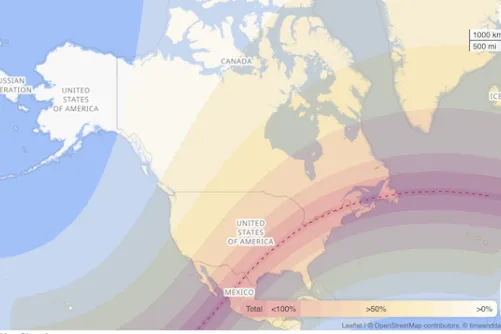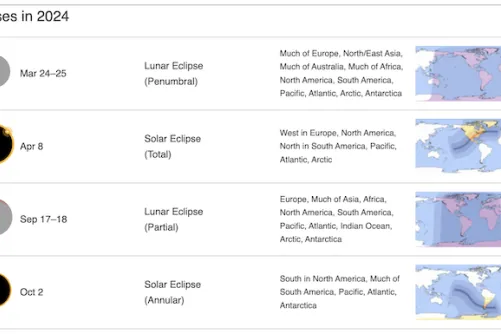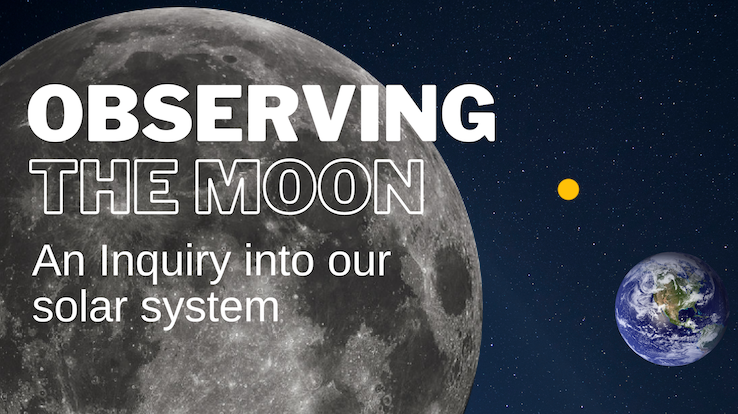Investigating a solar eclipse: Uncovering the relationship among the Earth, Moon & Sun
On April 8, 2024, North America will be treated to a spectacular event: a solar eclipse. As the moon aligns itself precisely between the Earth and the Sun, its shadow will be cast across our planet. Beyond the sheer spectacle, solar eclipses reveal a solar system ruled by precise mathematical and scientific rules. It’s a rare opportunity to pique children’s curiosity and deepen their understanding of the relationship between the Earth, Moon and Sun.
Why don’t we have an eclipse every month?
Asking “Why don’t we have an eclipse every month?” is a great way to think critically about the spatial requirements of an eclipse and really develop a deeper understanding of the Earth-Moon-Sun system. Solar eclipses do not occur with the same frequency in any specific area. The occurrence of eclipses depends on various factors, including the alignment and orbits of the Earth, Moon, and Sun. On average, though, a total solar eclipse is visible from any specific location on Earth approximately once every 375 years. This means that, while eclipses do occur regularly around the world, the chance of witnessing a total solar eclipse from a particular location is relatively rare.
In this lesson from Discover the Universe, students create a scale model of the Earth-Moon system using meter sticks and balls. By manipulating the model, students observe how alignment leads to different types of eclipses and gain insight into the Earth-Moon-Sun relationship.
Solar Eclipse Facts and Resources
An extraordinary coincidence
The synchronization observed during a total solar eclipse, where the Moon and Sun appear almost exactly the same size in the sky, is the result of an extraordinary coincidence. The diameter of the Moon is roughly 3,475 km, while the Sun’s diameter is about 1,391,000 km. When we compare these figures, we find that the Sun’s diameter is nearly 400 times that of the Moon. If both were at the same distance from Earth, the Sun would appear 400 times wider than the Moon in the sky. For a total solar eclipse to occur, however, the Moon must appear large enough in our sky to completely cover the Sun. Remarkably, this is exactly what happens during a total solar eclipse. With the Sun at an average distance of 150 million km from the Earth, and the Moon at approximately 384,400 km, the Sun is about 400 times further away from Earth than the Moon, perfectly balancing out the size discrepancy of the two. As a result, the Moon can completely obscure the Sun, creating the awe-inspiring phenomenon of a total solar eclipse.
An opportune time for scientific observation
The precise alignment of an eclipse reveals the Sun’s corona, a sight otherwise hidden from view. Scientists seize this opportunity to study the corona because they can see details of its intricate structure against the darkened sky. A solar eclipse played a pivotal role in proving that light bends due to gravity, a phenomenon predicted by Albert Einstein’s General Theory of Relativity. Einstein predicted the Sun’s massive gravitational field would bend the light from the stars as it passed near the Sun, causing the stars to appear slightly shifted in position from where they would normally be seen in the sky. Observations made during an eclipse on May 29, 1919, confirmed this prediction when the positions of the stars were observed in accordance with Einstein’s calculations.
Total, partial and annular eclipses
The path of totality is the specific area on Earth where the Moon’s shadow completely obscures the Sun. It is typically about 160 km wide, but as it races across the earth’s rotating surface at a speed of 1600 km/hr, it will span across thousands of kilometres. On April 8, 2024, the path of totality will begin in Mexico and travel northeastward through the United States into Ontario before reaching Quebec and the Maritime provinces. Within this path, the temperature can drop by as much as 8.3 degrees Celsius, showcasing the Sun’s influence on the Earth’s environment.
If you are outside the path of totality, you will experience a partial solar eclipse, where the Moon only partially covers the Sun from your perspective. The extent of coverage depends on your location relative to the path of totality, with those closer experiencing more obscuration. While the Sun won’t be completely covered, you will notice a dimming of the sky. Partial solar eclipses provide a fascinating opportunity to observe crescent moon-shaped shadows created by dappled sunlight filtering through tree leaves or other objects.
The next solar eclipse visible from North America will occur on October 14, 2023. This eclipse will be an annular solar eclipse. During an annular eclipse, the Moon appears smaller than the Sun in the sky because it is ever-so-slightly further away from the Earth, leaving a ring of sunlight visible around the dark silhouette of the Moon.

A graphic of the path of totality as the moon’s shadow crosses Earth’s surface on April 8, 2024. Determine whether your location will experience a total or partical eclipse

The dates of past and future eclipses show the patterns and cycles of celestial events. While complex, historical data can show how eclipses occur in predictable intervals.
